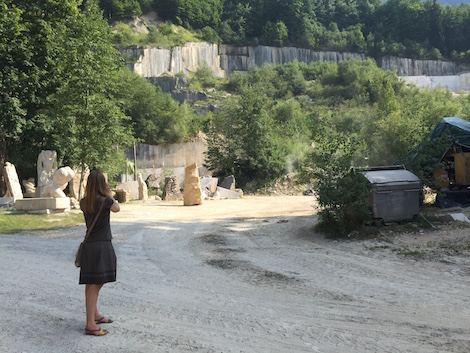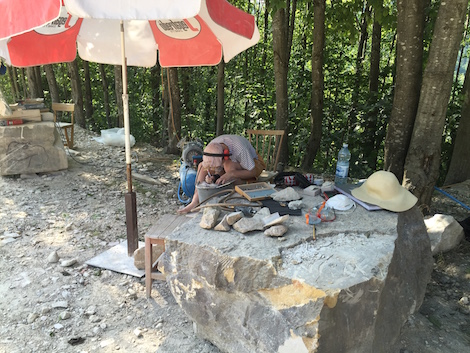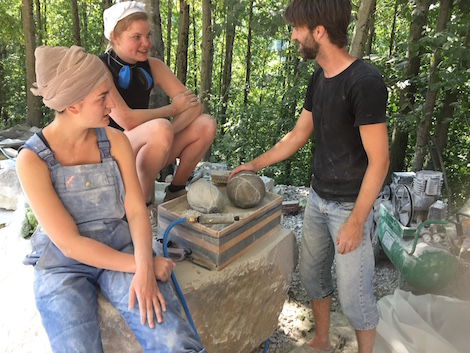| « 21 / 30 The legacy of gazes | 19 / 30 This is how the world is (too / not) » |
20 / 30 Intimate materials
Time passes differently at the quarry. I get this impression when preparing my trip to Peter Niedertscheid’s stone sculpture class. The class is living and working for four weeks at a quarry at the foot of the Untersberg south to Salzburg. If you google Untersberg, your first hits are conspiracy theory forums and forums on esotericism:
“On the day of the earthquake in Nepal the Untersberg was bleeding.”
“The emperor Charlemagne lives in the depths of Untersberg. Once in hundred years he awakes with his court and goes to its peak. If he sees ravens, he goes to sleep for another hundred years, if the ravens are gone, he will leave the mountain to fight the last battle of humanity against the anti-christ.”
“Once a wedding party followed a small man into the mountain and after dinning there they fell asleep for 500 years.”
Many of the myths and theories about the mountain are about anomalies in time. When I arrive at the quarry and see the different stone sediments, I get an idea why the mountain is such an object of fascination for many. You see the layers in the stone and realize how small the fraction of time is that you inhabit as an individual compared to the time of the stone.

The students work with this stone, the Untersberg-marble. It is a limestone that is extracted from the quarry and has been used for stone sculptures since antiquity. “Everything starts with the material, you have take time to find the right stone to work with” tells me Peter Niedertscheider. Only on Sundays the class is alone in the quarry. Then the workers, who extract the stone leave the site. So, only on Sundays the class can stroll around in all parts of the quarry to look out for stones to work with. “Choosing the stones has to be in the morning otherwise one doesn’t see flaws”.
No class is more intimate with its materials than Peter Niedertscheider’s. Not only do they create sculptures. They are also studying the stones surrounding them: how is the stone extracted? How does it change after rain? How does the heat affect it? How does it smell?
When you watch them working, fine dust fills the air. You smell the stone and literally breath it. Peter tells me that every stone has its own smell. Most of the students work on small dimension objects, not larger than a head of lettuce. “The dimension is already a solution. You can transport it easier, it is much cheaper and you have more time to carve out details.”

One of the students works on a sculpture of an apricot kernel of the size of a football. “This might seem easy at first, but if you watch carefully there is a lot of form in the kernel.” The tool she is using looks like a larger-than-life dentist drill. Peter tells me that stone sculpture is not taught at many art schools anymore. For most of the students this is the main reason for taking the class. They want to exploration stone as material for their artistic practice.

When I leave, I notice the soundscape in the quarry. I imagined it to be a silent space only disrupted by the sound of hammer and wedge forming stones. In contrast, you hear the buzzing of compressor motors, the whir of saws and drilling machines cutting through the heat of the afternoon. “It’s a matter of time. You can work much faster with machines” tells me Peter Niedertscheider. “Working with stone takes time, even if you work with machines."

